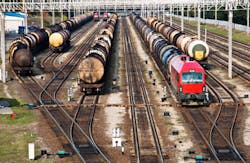New pipelines are being built, but rail will always play a significant role in the transportation of crude oil across the United States and Canada because of its ability to reach refineries unconnected by pipelines.
The amount of crude oil transported by rail in North America is projected to peak between 2015 and 2016 at about 1.5 million barrels per day (mbd), representing more than 10 percent of North American production, according to a new report by IHS. And the research firm says that rail will remain a key component of the region's oil production over the long-term.
With the boom in production in recent years, rail transport of crude oil in North America increased from around 20,000 barrels per day (b/d) in 2009 to more than 950,000 b/d in 2013 (almost 9 percent of production). In 2014, IHS expects the transport of crude by rail to average about 1.1 million barrels per day.
"Rail transport of crude oil has become an enabler of growth in North America, playing a crucial role as pipeline capacity has struggled to keep pace with the rapid rise of North American oil production since 2008," commented Kevin Birn, director for IHS Energy. "Despite the recent price volatility crude by rail is here to stay and will continue to play an important role going forward."
Even with new pipeline capacity coming into operation, more than 900,000 b/d are likely to be transported by rail in North America through the end of the decade, the report says.
For producers and refiners with little or no access to pipelines, rail provides a vital link from inland production, Birn pointed out.
"For instance there are refiners on the coast, particularly in the east, designed to import crude oil from offshore. Railroads provide coastal refiners originally designed to run offshore crude oil, access to a growing inland North American supply of similar quality at a lower price," he added.
